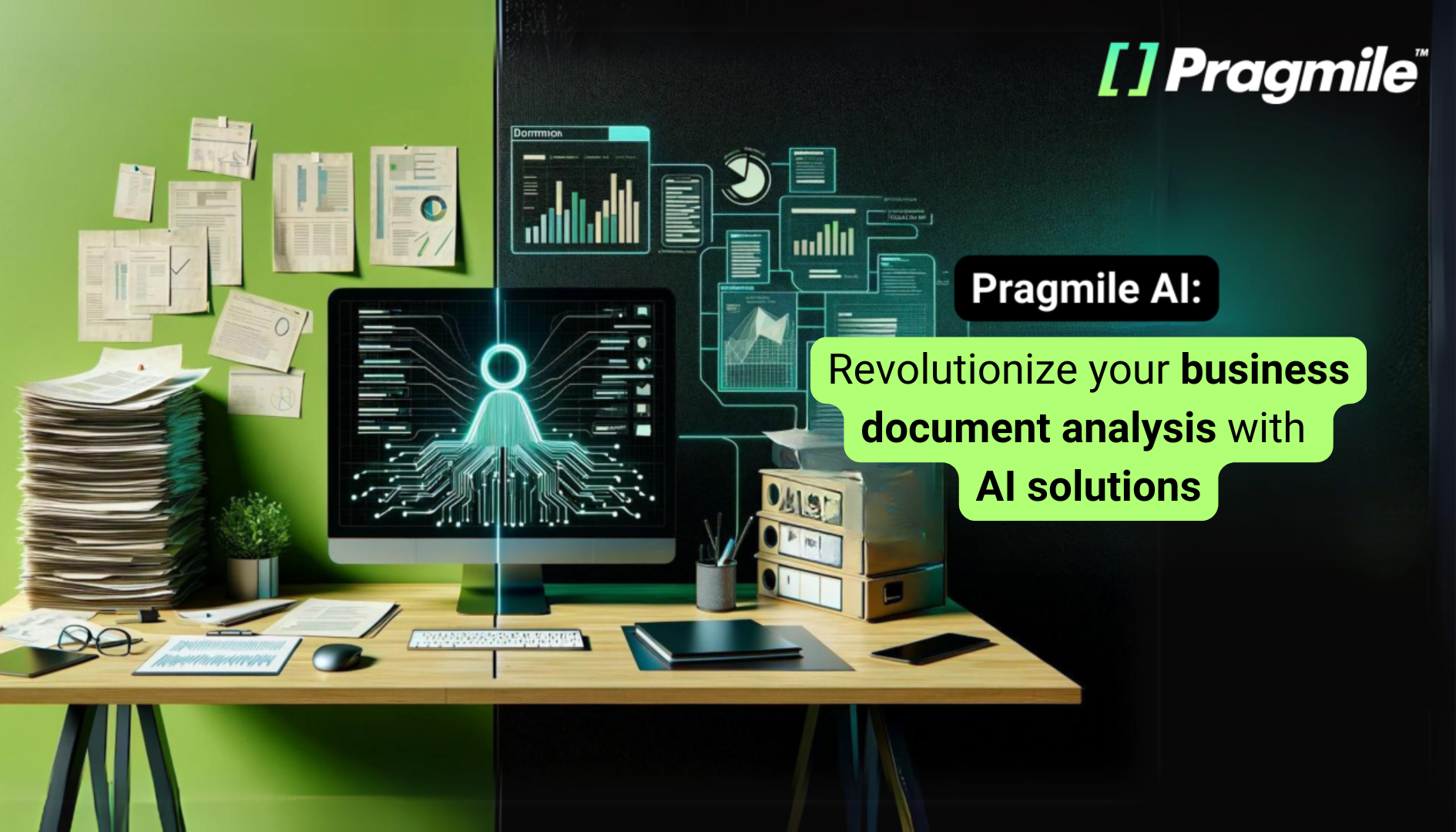
Published: 21 March 2025
Using Artificial Intelligence to Analyze Documents in Companies – The AI Revolution That Changes the Rules of the Business Game
Piles of papers, dozens of files, analyzing documents, drawing conclusions, creating summaries. Does this sound like a tedious process that takes up valuable time at work for your employees?
Imagine a world in which digging through piles of online and offline documents, extracting important information and preparing comprehensive summaries becomes a thing of the past. You free up resources that allow you to address business challenges that your team has not had the processing capacities to handle so far. You get much more accurate, comprehensive results from any document analysis. You make better business decisions.
Although this sounds like a futuristic vision of a utopian enterprise, it is already a very real solution, ready to be implemented in your company. And all this thanks to the development of artificial intelligence (AI), and specifically large language models (LLM), such as ChatGPT, which you have certainly heard about.
Traditional Methods of Document Analysis in Companies – Painstaking Work Burdened with Human Risk
It has long been known that potential human errors significantly increase the level of risk of undertaken projects. Especially business ones, based on intensive mental work. Such projects certainly include the analysis of company documents, which plays a key role in decision-making and information management.
Manual review of paper and digital documents, most of which first had to be scanned. Extracting the most important data from them, and then manually coding, entering them into spreadsheets or databases to facilitate searching and analysis. This is certainly the everyday life of many teams in your company.
Although it may seem to you that the matter is solved by optical character recognition (OCR) software, which automatically converts scans to digital text and facilitates keyword searching, this process still requires manual review and coding, and the documentation must be manually updated. In a word, backbreaking, painstaking work that will sooner or later finish off even the most solid employee.
Traditional methods of document analysis in companies always have hidden challenges. Such processes are time-consuming, labor-intensive and error-prone, and therefore cost-intensive. They make it difficult to search for and analyze information from a large number of documents, and also slow down business processes, which often prevents scalability.
These arguments seem to be enough to look for a solution that will support key areas of your company and allow you to make faster and more accurate decisions, and to entrust employees with much more interesting tasks than reading, manually sorting and extracting key information from contracts, reports or emails, which can take hours.
Large Language Models (LLMs) – The Superheroes of Your Enterprise Analytics at Your Fingertips
Large language models like ChatGPT are a groundbreaking technology. They are a type of artificial intelligence that has been trained on massive sets of language data.
They can generate, process, and analyze text in a way that mimics human thinking. LLMs can understand context and extract important information from large sets of documents. As you can imagine, this makes them incredibly useful tools for automating enterprise document analysis processes.
See what tasks large language models can perform to improve your business:
- Text Analysis: LLMs can read and understand documents, extracting key information from them.
- Document Classification: LLMs can automatically categorize documents by subject matter, such as contracts, invoices, reports.
- Summaries: Creating short and clear summaries of the most important issues in documents is no challenge for LLMs.
- Answering Questions: LLMs can answer specific questions about the content of documents.
Not Just ChatGPT – The Biggest Players in the Large Language Model Market
There are many LLM models available on the market that can be useful for document analysis in companies like yours. Below you will find some of them.
- ChatGPT (OpenAI) – one of the most popular LLMs, known for its versatility and ability to generate realistic text. In addition, it is free for all users. With it, you can automate many document analysis tasks, such as: summarizing and categorizing documents, extracting key information from them, or translating them into foreign languages.
- Jurassic-1 Jumbo (AI21 Labs) – LLM with impressive accuracy and processing speed. It is particularly well-suited to analytical tasks, such as: checking the correctness of information contained in documents, identifying unusual patterns or deviations in data, or providing comprehensive answers to questions about the content of documents.
- Megatron-Turing NLG (Microsoft) – this LLM stands out for its ability to generate various text formats. It can be helpful in tasks related to content creation, such as: automatically generating reports based on data contained in documents or preparing presentations containing key information from documents.
- Bloom (Hugging Face) – an LLM with an open architecture, thanks to which it can be adapted to specific business needs. It will be useful for analyzing sentiment (determining opinions and moods expressed in documents), identifying the main topics discussed in documents, and also segmenting text into smaller, coherent fragments.
- WuDao 2.0 (Beijing Academy of Artificial Intelligence) – an interesting player in the LLM industry, dedicated to the Chinese language. It is a valuable tool for companies operating in the local market, which, among other things, translates documents from Chinese to other languages and vice versa, adapts content to the Chinese cultural context, and performs analytical tasks based on Chinese documents.
AI + Human – Synergy Effect in the Analysis of Corporate Documentation
All of the aforementioned large language models are available via the API interface and can be integrated with various corporate systems, such as CRM, ERP and other business tools, for example for content management or marketing automation. This allows for smooth implementation of this solution in existing company structures.
Introducing artificial intelligence to the document analysis process in your business can bring many benefits. Thanks to their advanced algorithms, LLMs can quickly search large amounts of text, automatically classify documents, extract key information and generate shortcuts, which significantly speeds up and facilitates the analysis process and improves the management of information resources in the company.
Each of the previously mentioned LLMs has its unique advantages and disadvantages, so it is important to choose the one that best suits the specific needs of your company. Most of them are still in the development phase – so they can generate incorrect or misleading information. Keep this in mind and do not give up on the staff who will implement these solutions in your company.
A person familiar with artificial intelligence and using it for routine tasks can become much more efficient and accurate, focus on strategic activities. If you decide on such a revolution in your company and instead of a narrative about AI reducing jobs, you focus on showing employees opportunities for development, the synergy effect is guaranteed. Companies that implement LLM for document analysis can undoubtedly gain a competitive advantage thanks to increased efficiency, meticulousness and better decision-making.
Before starting work with a specific LLM, familiarize yourself with its capabilities, limitations and terms of use. Also remember that large language models are powerful tools, so use them responsibly in your company. It is best if you establish clear guidelines for using LLM, which will ensure that these tools are used in an ethical manner, in line with the values and goals of your company.
Practical Applications of LLM in your Company
When it comes to analyzing company documents, LLM is really simple and consists of a few steps:
- You or your employee sends text files, emails or contracts to the LLM-based system.
- LLM processes the documents, extracts key information and dependencies.
- You receive ready-made summaries, classifications and answers to your questions about the documents.
To simplify things even more, we will present it with examples of real benefits that large language models can bring to specific departments in your company:
- Sales Department: LLM will analyze offers and emails from potential customers to identify their needs and speed up the sales process.
- Accounting Department: LLM will automatically classify invoices and extract data needed for accounting.
- Legal Department: LLM will analyze contracts and detect potential legal risks
- HR Department: LLM will analyze CVs and cover letters to identify candidates who fit the job profile.
As you can see, implementing large language models in your company will significantly reduce the time needed for document analysis, which will allow your employees to focus on more strategic tasks. Secondly, it will improve the accuracy of analysis, eliminating human errors and providing more consistent results. In addition, thanks to the scalability of LLM, your company can start to efficiently process large volumes of documents, which will allow you to make decisions faster and react to changes in the business environment.
It’s Time for a Revolution in the Analysis of your Company Documents – Use the Potential of LLM Today
Implementing AI for document analysis does not require extensive technical knowledge and can bring significant benefits to various departments and business processes in your company. There are many solutions available dedicated to companies that facilitate the integration of LLM with existing systems and processes.
Artificial intelligence will soon make its home in the business world. As technology develops, the role of LLM in document analysis will grow. Large language models will certainly gain even greater precision and versatility in the analysis of natural language. This will make them able to generate more detailed and comprehensive reports and analyses.
In turn, their integration with other IT systems in enterprises will automate entire business processes. And the automation of these processes can speed up decision-making and increase operational efficiency.
As artificial intelligence technology develops, further innovations in the field of document analysis are inevitable. So consider how your company can use this innovative technology to gain a competitive advantage in the market in the near future.
Schedule a free consultation with
our AI and technology experts
Take advantage of the latest AI solutions, tailored to your company's needs. Book a consultation with AI solution architects at Pragmile and discover new opportunities in energy management.
Please, provide your business email to schedule a meeting

